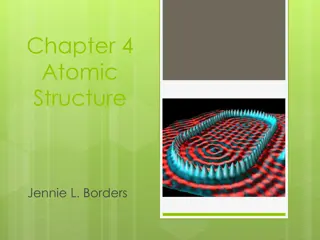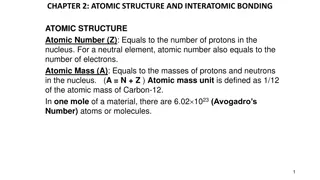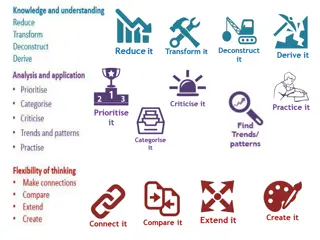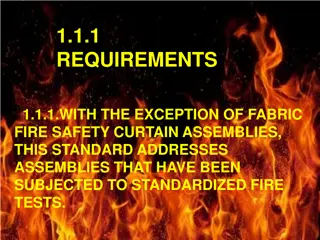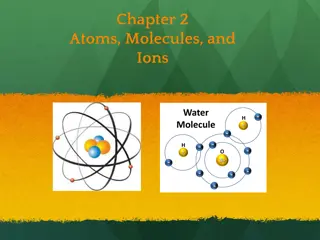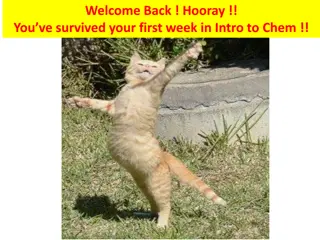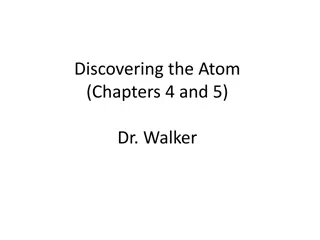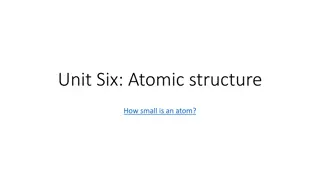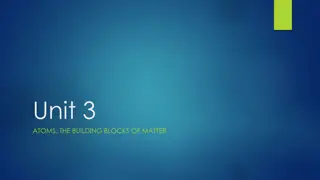Evolution of Atomic Models: From Dalton to Bohr
Explore the progression of atomic models from John Dalton's theory of tiny, structureless particles to J.J. Thomson's Plum Pudding model, Ernest Rutherford's discovery of the nucleus, and finally Niels Bohr's model with fixed electron orbits and energy levels. Witness the journey of scientific understanding of the atom through history.
Download Presentation

Please find below an Image/Link to download the presentation.
The content on the website is provided AS IS for your information and personal use only. It may not be sold, licensed, or shared on other websites without obtaining consent from the author.If you encounter any issues during the download, it is possible that the publisher has removed the file from their server.
You are allowed to download the files provided on this website for personal or commercial use, subject to the condition that they are used lawfully. All files are the property of their respective owners.
The content on the website is provided AS IS for your information and personal use only. It may not be sold, licensed, or shared on other websites without obtaining consent from the author.
E N D
Presentation Transcript
Models of the Atom Rutherford used existing ideas about the atom and proposed an atomic model in which the electrons move around the nucleus, like the planets move around the sun.
Rutherfords atomic model could not explain the chemical properties of elements. Rutherford s model fails to explain why objects change color when heated.
Models of The Atom 1863- John Dalton pictures atoms as tiny, indestructible particles, with no internal structure.
Models of the Atom 1897- J.J. Thomson, a British scientist, discovers the electron. The later leads to his Plum Pudding model. He pictures electrons embedded in a sphere of positive electrical charge.
Models Of the Atom 1911- Ernest Rutherford finds that an atom has a small, dense, positively charged nucleus. Electrons move around the nucleus.
Models of the Atom 1913- Neils Bohr s model, the electron moves in a circular orbit at fixed distances from the nucleus.
The Bohr Model Bohr proposed that an electron is found only Bohr proposed that an electron is found only in specific circular paths, or orbits, around the in specific circular paths, or orbits, around the nucleus. nucleus. Each orbit has a fixed energy. These fixed Each orbit has a fixed energy. These fixed energies an electron can have are called energies an electron can have are called energy levels. energy levels.
These ladder steps are somewhat like energy levels. The higher an electron is on the energy ladder, the farther it is from the nucleus. quantum of energy is the amount of energy required to move an electron from one energy level to another energy level. Nucleus
To move from one energy level to another an electron must gain or lose just the right amount of energy. The higher an electron is on the energy ladder, the farther from the nucleus.
The Bohr Model The Bohr model establishes the concept of definite electron energy levels within atoms. But Bohr's model was rather simplistic and as scientists made more discoveries about more complex atoms, Bohr's model was modified and eventually was replaced by more sophisticated models.
Models Of the Atom 1926- Erwin Schrodinger develops mathematical equations to describe the motion of electrons in atoms. His work leads to the electron cloud model.
The Quantum Mechanical Model The modern description of the electrons in atoms, the Quantum Mechanical Model, comes from the mathematical solutions to the Schrodinger equation. Like the Bohr model, the quantum mechanical model of the atom restricts the energy of electrons to certain values. Unlike the Bohr model, however, the QMM does not involve an exact path the electron takes around the nucleus.
Key Concept!!! The Quantum Mechanical model determines the allowed energies an electron can have and how likely it is to find the electron in various locations around the nucleus.
Atomic Orbitals An atomic orbital is often thought of as a region of space in which there is a high probability of finding an electron. Each energy level corresponds to an orbital of a different shape, which describes where the electron is likely to be found.
Atomic Orbitals Cont The numbers and kinds of atomic orbitals depend on the energy sublevel. The lowest principal energy level (n=1) has only one sublevel, called 1s. The second level (n=2) has two sublevels, 2s and 2p. Thus, the second energy level has four orbitals: 2s, 2px,2py,2pz. The third level (n=3) has three sublevels, 3s,3p and 3d. Thus the third energy level has nine orbitals: one 3s, three 3p, and five 3d. The fourth level (n=4) has four sublevels, 4s,4p,4d, and 4f. Thus the fourth energy level has 16 orbitals: one 4s, three 4p, five 4d, and seven 4f orbitals.
Maximum # of Electrons Energy level n 1 2 3 4 Max. # of electrons 2 8 18 32
5.2 Electron Arrangement in Atoms The ways in which electrons are arranged in various orbitals around the nuclei of atoms are called electron configurations. Three Rules- the Aufbau Principle, the Pauli exclusion principle, and Hund s rule- tell you how to find the electron configurations of atoms.
Aufbau Principle Electrons occupy the orbitals of lowest energy first.
Pauli Exclusion Principle An atomic orbital may describe at most two electrons. For example, either one or two electrons can occupy an s or p orbital. To occupy the same orbital, two electrons must have opposite spins; that is, the electron spins must be paired.
A. General Rules Pauli Exclusion Principle Each orbital can hold TWO electrons with opposite spins.
Hunds Rule Electrons occupy orbitals of the same energy in a way that makes the number of electrons with the same spin direction as large as possible.
A. General Rules Hund s Rule Within a sublevel, place one e-per orbital before pairing them. Empty Bus Seat Rule RIGHT WRONG
B. Notation Orbital Diagram O 8e- 2s 2p 1s Electron Configuration 1s2 2s22p4
B. Notation Longhand Configuration S 16e- 1s22s22p63s23p4 Core Electrons Valence Electrons Shorthand Configuration S 16e- [Ne]3s2 3p4
C. Periodic Patterns Example - Hydrogen 1st column of s-block 1s 1 1st Period s-block
Practice, Practice, Practice!!! Write the electron configurations for each atom. Carbon Carbon Argon Argon Nickel Nickel



